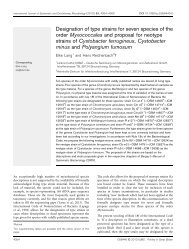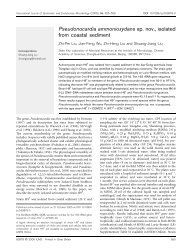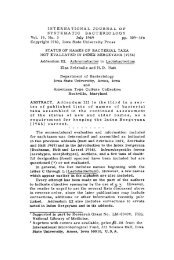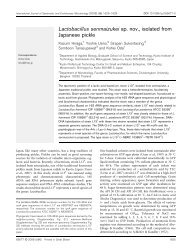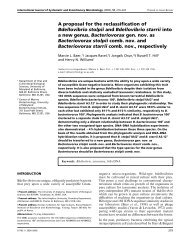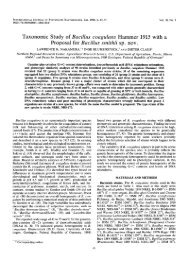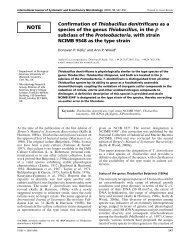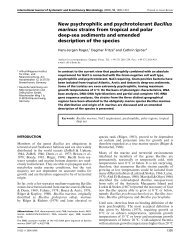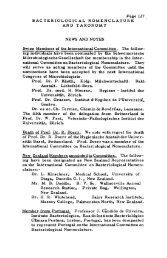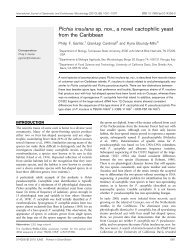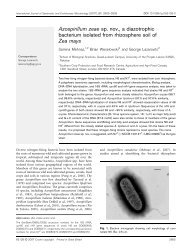Curvibasidium cygneicollum gen. nov., sp. nov. and Curvibasidium ...
Curvibasidium cygneicollum gen. nov., sp. nov. and Curvibasidium ...
Curvibasidium cygneicollum gen. nov., sp. nov. and Curvibasidium ...
You also want an ePaper? Increase the reach of your titles
YUMPU automatically turns print PDFs into web optimized ePapers that Google loves.
J. P. Sampaio <strong>and</strong> others<br />
Table 1. Strain numbers, isolation source <strong>and</strong> sexuality of the two <strong>nov</strong>el <strong>sp</strong>ecies of <strong>Curvibasidium</strong> described in this study <strong>and</strong><br />
of R. nothofagi<br />
Species/strain* Isolation source SexualityD<br />
C. <strong>cygneicollum</strong><br />
CBS 4551 T d Hare faeces, Mount Fuji, Japan MT A1<br />
CBS 7950 Wood of Quercus suber, Arrábida, Portugal MT A1<br />
CBS 8056 Berry of Vitis coignetiae (wild grape), Japan MT A1<br />
PYCC 4187 Flower of Acacia <strong>sp</strong>., Portugal MT A1<br />
CBS 6371 Leaf, France MT A2<br />
PYCC 4694 Rotten wood, Arrábida, Portugal MT A2<br />
CBS 8163§ Rotten trunk of Laurelia sempervirens, Futrono, Chile ANA<br />
CBS 7949 Dry leaf, Arrábida, Portugal SF||<br />
CBS 7951 Tree root, Gerês, Portugal ANA<br />
CBS 8264 Leaf of Acacia <strong>sp</strong>., New Zeal<strong>and</strong> ANA<br />
PYCC 4705 Caterpillar nest, Sintra, Portugal ANA<br />
PYCC 4445 Woodl<strong>and</strong> soil, Lisbon, Portugal ND<br />
PYCC 4968 Tree trunk, Arrábida, Portugal ANA<br />
PYCC 4947 Rotten tree trunk, Lisbon, Portugal ANA<br />
VKM Y-2859 Herbaceous plants, Prioksko-terrasny Bio<strong>sp</strong>here Reserve, Moscow region, Russia MT A2<br />
JI 06 Fruiting body of Exidiopsis <strong>sp</strong>., Caramulo, Portugal ND<br />
JI 21 Fruiting body of Exidiopsis <strong>sp</strong>., Caramulo, Portugal ND<br />
C. pallidicorallinum<br />
VKM Y-2284 T (=CBS 9091 T ) Gramineous plant, Moscow region, Russia MT A1<br />
CBS 6231 Frass of Ruguloscolytus rugulosus MT A1<br />
VKM Y-2861 Herbaceous plants, Prioksko-terrasny Bio<strong>sp</strong>here Reserve, Moscow region, Russia MT A2<br />
VKM Y-1135 Air, Kishinev, Moldavia MT A2<br />
VKM Y-2860 Herbaceous plants, Prioksko-terrasny Bio<strong>sp</strong>here Reserve, Moscow region, Russia MT A1<br />
PTZ 185 Herbaceous plants, Prioksko-terrasny Bio<strong>sp</strong>here Reserve, Moscow region, Russia MT A1<br />
R. nothofagi<br />
CBS 8166 T Rotten trunk of Nothofagus obliqua, Futrono, Chile ANA<br />
A45 Sea water off Faro, south of Portugal ANA<br />
*CBS, Centraalbureau voor Schimmelcultures, Yeast Division, Utrecht, The Netherl<strong>and</strong>s; PYCC, Portuguese Yeast Culture Collection, FCT-UNL,<br />
Portugal; VKM, All-Russian Collection of Microorganisms, Pushchino, Russia; JI, PTZ personal collections of J. Inácio <strong>and</strong> W. I. Golubev,<br />
re<strong>sp</strong>ectively; A, collection of yeasts isolated from aquatic environments by M. Gadanho <strong>and</strong> J. P. Sampaio.<br />
DANA, Anamorphic; MT, mating type; ND, not determined.<br />
dType strain of R. fujisanensis (Soneda) Johnson & Phaff.<br />
§Type strain of Rhodotorula futronensis (Ramírez & González) Roeijmans et al.<br />
||Originally this strain was self-fertile, but currently it lacks the ability to produce mycelium with telio<strong>sp</strong>ores.<br />
measure 1?5–2?5615–35 (50) mm. Basidia [6–8 (10)615–<br />
22 (26) mm] are devoid of septa <strong>and</strong> produce sessile, ovoidto-bacilliform<br />
basidio<strong>sp</strong>ores [1?5–266–12 (20) mm] on<br />
short basidial appendages (Fig. 2b). Each basidium has two<br />
to four sites of basidio<strong>sp</strong>ore formation <strong>and</strong> multiple<br />
basidio<strong>sp</strong>ores are formed at each site. Basidio<strong>sp</strong>ores<br />
germinate by budding. Yeast cells are long <strong>and</strong> ovoid to<br />
cylindrical [(1?5) 2–36(5) 7–12 (15) mm] (Fig. 2a). Streak<br />
cultures are cream-coloured or pale orange, butyrous<br />
<strong>and</strong> semi-dull. Colony margins are entire, <strong>and</strong> fringed<br />
with pseudomycelium in some cases. Physiological<br />
<strong>and</strong> biochemical features of C. <strong>cygneicollum</strong> are available<br />
at http://www.crem.fct.unl.pt/dimorphic_basidiomycetes/<br />
Databases/databases.htm <strong>and</strong> tests that allow its differentiation<br />
from <strong>Curvibasidium</strong> pallidicorallinum are depicted in<br />
Table 2. The phylo<strong>gen</strong>etic placement of C. <strong>cygneicollum</strong> is<br />
shown in Fig. 1. C. <strong>cygneicollum</strong> is sensitive to the mycocins<br />
produced by Rhodotorula glutinis <strong>and</strong> Rhodotorula mucilaginosa,<br />
but insensitive to mycocins secreted by Rhodotorula<br />
pallida <strong>and</strong> by <strong>sp</strong>ecies of the <strong>gen</strong>era Cryptococcus,<br />
Cystofilobasidium, Filobasidium <strong>and</strong> Sporidiobolus.<br />
Microscopic slides from the crossing of CBS 4551 T <strong>and</strong> CBS<br />
6371, showing mycelium, telio<strong>sp</strong>ores, basidia <strong>and</strong> basidio<strong>sp</strong>ores,<br />
were deposited in the Portuguese Yeast Culture<br />
Collection under number ZP-01-03 (holotype). As the<br />
physiological <strong>and</strong> molecular characterization of a mixed<br />
culture presents obvious difficulties, we propose that<br />
strain CBS 4551 T , isolated from hare droppings collected<br />
at Mount Fuji, Japan, should be designated as the type<br />
strain of C. <strong>cygneicollum</strong>. This strain is deposited in the<br />
Centraalbureau voor Schimmelcultures, Yeast Division,<br />
1404 International Journal of Systematic <strong>and</strong> Evolutionary Microbiology 54



